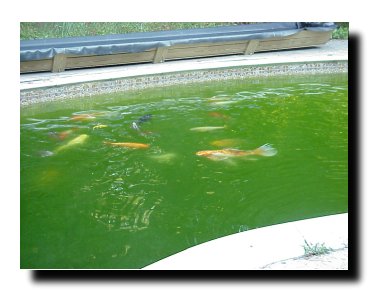Converted swimming pools
Converted swimming pool bear mentioning because they are a superb way to enjoy fish.

Many people move into a home with a vinyl-sided-in-ground swimming pool in the back yard. The seller tells you (as she fishtails down the driveway after the closing); “The pool needs some work!” And she’s gone. You find out the pool is a total “redo”. Why not consider throwing an EPDM rubber liner in it and calling it a great big rectangular fish pond?
Gunnite and other in ground swimming pools also make excellent fish ponds, especially when the sides are treated with a paint-on rubber compound or other inert sealer. Gunnite pools will leach carbonates and other minerals as they deteriorate. There’s concrete behind the gunnite which begins to leach as the gunnite thins and perforates. This is common in older Gunite pools; the very kind you’d consider converting to fish use.
When considering the conversion of a pool to fish use, the key is to replace the filter with a very sizeable bead filter or other filter suitable for the enormous volume usually implied with a swimming pool conversion. You should fill the pond after the sides are prepared either with a sealer or EPDM, and allow some time to pass before inhabiting it. Make sure that you monitor the alkalinity and even have a test for Chlorine run to be sure there are no residuals anywhere near the pond.
The average swimming pool conversion offers the following advantages:
- An implied “enormity” which guarantees plenty of space for the fish.
- Readymade construction, the hole is already there, just throw a liner in it!
- Depth is usually excellent for safe overwintering of most fish.
- Depth is also excellent for maintaining safe summer temperatures as the pool will sink some heat into the earth’s crust which is 55 DF.
- Filtration is usually a simple task, because the plumbing is already in place. Simply cut out the sand or diatom filter and put a bead filter in it’s place.
- Pools of contemporary contruction are already fenced and decked so the safey of neighborhood kids is not compromised by such an installation.
Can you swim in the pool with the fish? Yes and no.
The extraordinary thing about Koi is that after a couple of dips, my Koi don’t care about us swimming around with them. We swim a couple times per week with our fish. The kids love it. Plus, it tends to stir up the bottom and allow the filter to collect the occasionally missed litter.
One of the reasons to *hesitate* concerning a swim with your Koi is the rare instance where you could contract a zoonosis (animal disease) during your swim. It’s important to note that you have just as good a chance of winning the lottery as you do of catching a fish disease, but it happens.
Here are the biggies: 1) Swimmers itch 2) Tuberculosis 3) Bacterial infection 4) Ophthalmic amoebiasis
I have known one person over the last ten years to catch any of the above.
Swimmer’s itch is not terribly common, because it requires a snail in the pond and a wading bird for transmission.
Of course, these vectors exist in lots of places but then the parasite which causes swimmer’s itch doesn’t. So it’s a rare convergence of factors to cause swimmer’s itch, but it happens. The pond should be drained and refilled, and then the snails killed off with copper sulfate or potassium permanganate.






